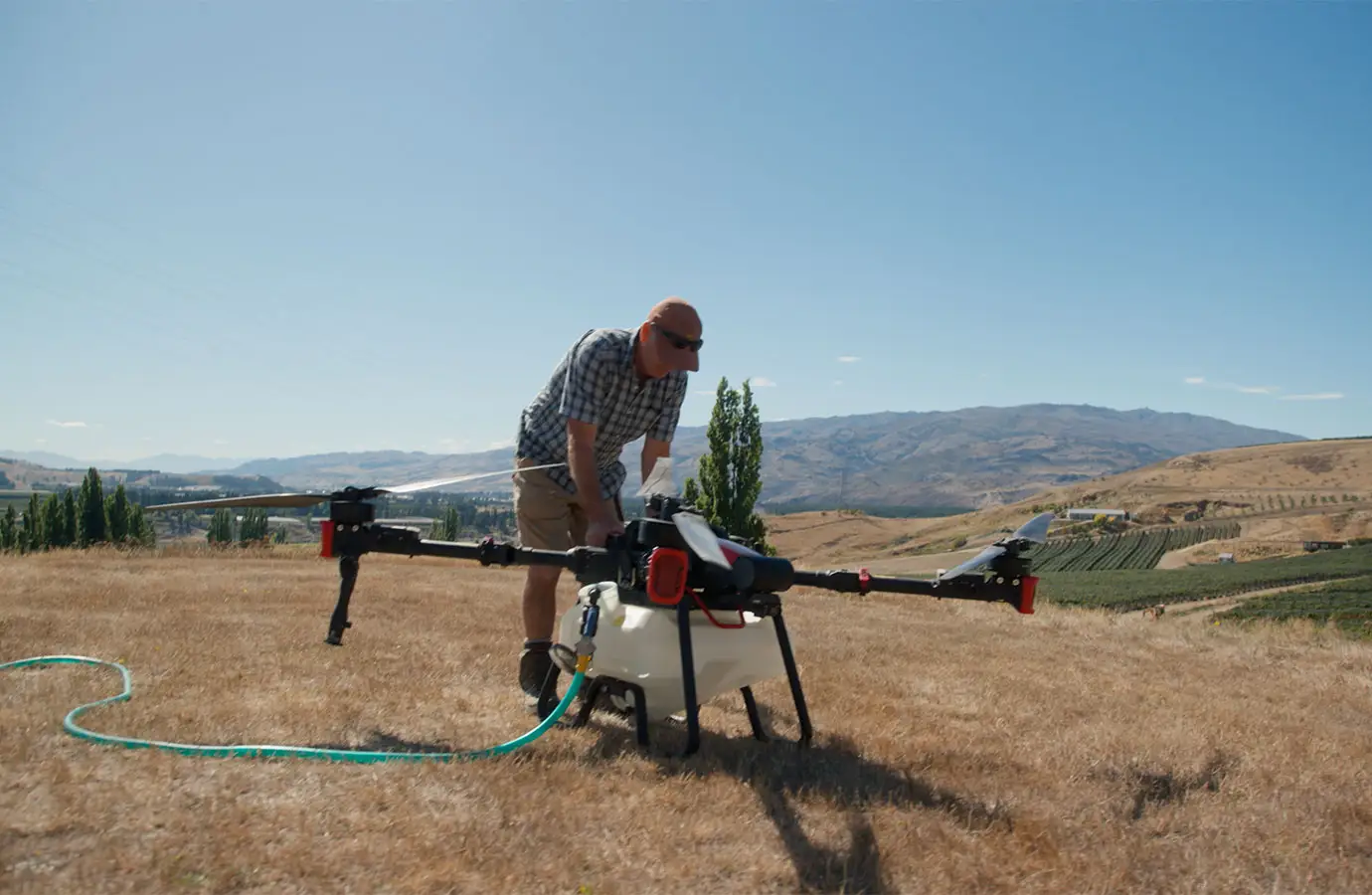Felton Road Wines in Bannockburn, Otago, is using an electric agricultural drone sprayer as an alternative to diesel-powered tractors and transforming its vineyard management.
Read about how the technology has helped the winery has improve energy efficiency, reduce costs, minimise health and safety risks, and enhance operational resilience.
Replacing the last dinosaur
The producer of certified organic and biodynamic Pinot Noir, Chardonnay, and Riesling wines has incorporated an electric agricultural drone sprayer to manage its 33 hectares of vineyard and surrounding land.
The shift to the P100 Pro XAG drone has reduced the vineyard’s diesel use by 18%, saving approximately 1,700 litres of fuel per year and cutting CO₂ emissions by 5 tonnes annually.
The team looked for drone technology that could carry enough weight, be reliable, and cover the vineyard.
“The drone is really the first chance we've had to work with something that isn't a tractor,” says vineyard owner Nigel Greening. “We know that the future is not tractors as they are heavy, cumbersome, use a lot of fuel and squash the soils and the land. The tractor was the vineyard’s last dinosaur.”
“Farming is tough – hot, cold, physically demanding. But technology like this makes it more attractive and sustainable. The drone runs fully electric. We charge it using our solar PV which saves on energy costs and diesel use,” says Greening.

Faster, safer, smarter
The drone applies certified organic fungicides, aligning with Felton Road’s biodynamic and regenerative farming philosophy. More than just an energy saving tool, the drone also improves health and safety. Tractors on steep terrain pose risks of tipping and fatigue-related accidents. The drone eliminates those hazards, reducing operators' chemical exposure and reducing soil compaction — preserving the ecosystem and cover crops. It also uses infrared sensors to map crop stress and nutrient needs.
Greening says the efficiency gains have been significant. The drone sprays 50-60% faster than traditional methods,
Beyond fuel savings, the drone reduces labour time by up to 60% compared to tractor spraying. Even accounting for battery and tank refills every five minutes, the drone completes the same job significantly faster.
Estate Manager Gareth King emphasises this, saying, “The drone can cover a hectare in just 20 minutes, while a tractor takes over an hour.”
The drone's ability to fly right after rain is another advantage. While tractors must wait for the ground to dry to avoid compacting the soil, drones can spray immediately. This is especially important when treating mildew with sulfur-based sprays after rainfall.
The drone has a 50-litre capacity and even with pauses for battery swaps and tank refills, consistently outpaces ground-based equipment, King says.
Advanced features like terrain-following radar, adjustable nozzles, and programmable mapping optimise coverage while minimising chemical use.
Greening says the winery is already seeing comparable results in disease control versus traditional tractors – especially for mildew management. The transition wasn’t without challenges – particularly in learning to operate the drone, but the team quickly adapted, benefiting from improved efficiency and biodiversity outcomes.

Benefits of an agricultural drone sprayer
The team at Felton Road have found many benefits to the drone sprayer.
- Cost savings — Can be charged via onsite solar PV, saving on energy and fuel costs
- Efficiency gains — Drones are 50–60% faster than ground spraying, even with 5-minute intervals for battery/tank changes
- Diesel & emissions reduction — Cuts diesel use by 18% (~1,700L/year), reducing CO₂ emissions by 5 tonnes annually
- All-weather readiness — Drone spraying can resume immediately after rain, unlike tractors which must wait for soil to dry
- Soil health — Drone use prevents soil compaction caused by heavy tractors, benefiting vine growth
- Health & safety improvements — Drones reduce operator exposure to fungicides and eliminate risky tractor manoeuvres on slopes.
A learning curve worth climbing
Vineyard Manager Annabel Bulk highlights benefit — improved health and safety. Steep slopes, heavy machinery, and chemical exposure are everyday hazards in vineyard operations. The drone virtually eliminates these risks.
“Flying it is thrilling but nerve-wracking. It demands careful setup and operation,” says Bulk. “But it's much safer than having someone drive a heavy tractor with hundreds of litres of spray across a hillside.”
To fully leverage the drone’s capabilities, Felton Road is investing in in-house skills. Training for drone operation, while rigorous, has proven worthwhile. Bulk describes the 10-day training process as a “steep but rewarding learning curve” and a unique opportunity to engage younger farming talent with cutting-edge agricultural practices.
“We jumped in headfirst. A lot of our early season sprays were a big learning curve, but now we have achieved spray coverage and disease control comparable to our tractors,” Bulk says. Initial scepticism was replaced by confidence, especially in managing mildew outbreaks.

Building technological resilience for the years ahead
For Felton Road, drones are more than a tool — they’re a glimpse of the vineyard’s future.
“The drone is one of those tools in our toolkit that we're going to be exploring and playing with. The great thing about any piece of technology is it frees up humans and gives them time to use their strengths.”
The team sees drones as a platform for future innovation. Greening is especially interested in emerging capabilities like infrared sensors to map vine stress, water needs, and nutrient levels from above.
There's also potential to use drones to spread pelletised compost — a development that would further reduce the need for heavy machinery and expand the drone’s utility across seasonal cycles.
Felton Road Wines received $20,000 co-funding for the P-100 XAG electric agricultural spraying drone through EECA’s (Energy Efficiency and Conservation Authority) Technology Demonstration Fund.
Browse EECA's selection of free tools, resources and case studies for the wine sector.
Read next
-
From sunlight to savings
A 54 kw solar PV system is paying off for this Wairarapa dairy farm.
- Case study
- Solar energy
-
From vine to green
How Wakatu Incorporation is planning for now and for the next 500 years.
- Case study
-
Fighting frost with electric fans
A cost and emissions saving opportunity for New Zealand growers.
- Case study
- Electricity
- Innovation


